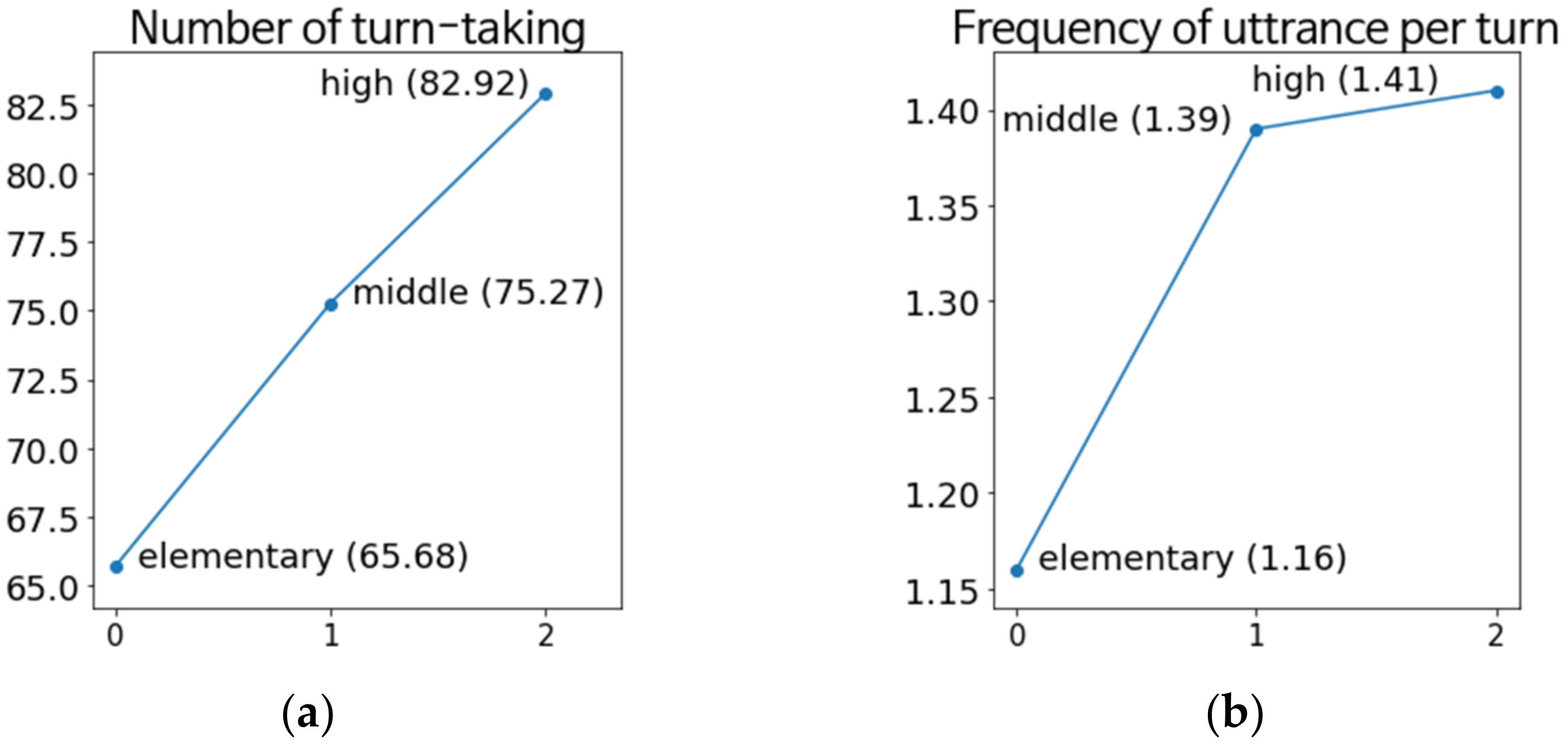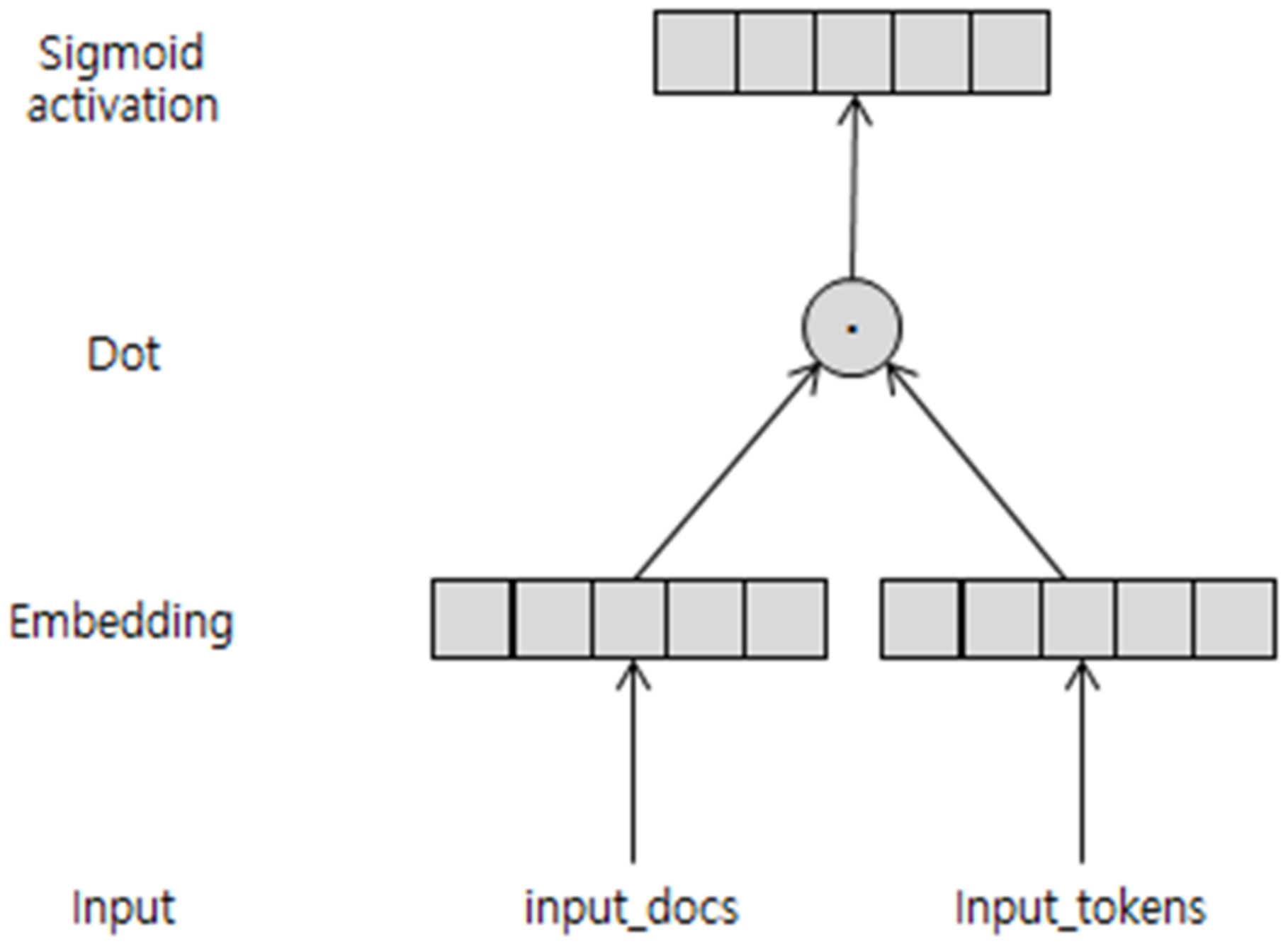Topic Modeling for Analyzing Topic Manipulation Skills
Abstract
1. Introduction
2. Related Works
3. Data
3.1. Data Collection
3.2. Data Examples
3.3. Data Analysis
4. Methods
4.1. Morphological Analysis
4.2. Topic Modeling
4.2.1. LDA
4.2.2. Doc2Topic
5. Experiment
Experimental Results
6. Conclusions
Author Contributions
Funding
Data Availability Statement
Conflicts of Interest
References
- Heo, H.S.; Lee, Y.K. Conversational turn-taking and topic manipulation skills in conversations of school-age low-achievers in language learning. Commun. Sci. Disord. 2012, 17, 66–78. [Google Scholar]
- Lee, H.J.; Kim, Y.T. Turn-Taking Characteristics of children with Specific Impairment and Normal Children. Commun. Sci. Disord. 2001, 6, 293–312. [Google Scholar]
- Kim, Y.T. A Study on the accuracy of consonants in pre-school children using the picture consonant test. Commun. Sci. Disord. 1996, 1, 7–34. [Google Scholar]
- Hong, J.H.; Pae, S.Y. The coda error patterns of children aged from 2 to 5. Korean J. Commun. Disord. 2002, 7, 294–304. [Google Scholar]
- Cunningham, A.-E.; Keith, E.-S. What reading does for the mind. Am. Educ. 1998, 22, 8–17. [Google Scholar]
- Shin, J.W.; Kim, J.Y. A Study of Korean Elementary School Students’ Usage of English Vocabulary Learning Strategies. J. Foreign Stud. 2017, 39, 65–86. [Google Scholar]
- Park, Y.J.; Choi, J.E.; Lee, Y.K. Development of topic management skills in conversation of school-aged children. Commun. Sci. Disord. 2017, 22, 25–34. [Google Scholar] [CrossRef]
- Yang, Y.W.; Lee, Y.K.; Choi, J.E.; Yoon, J.-H. Development of conversational skills from late children to adolescent. Commun. Sci. Disord. 2018, 23, 270–278. [Google Scholar] [CrossRef]
- Brinton, B.; Fujiki, M. Development of topic manipulation skills in discourse. J. Speech Lang. Hear. Res. 1984, 27, 350–358. [Google Scholar] [CrossRef] [PubMed]
- Schober-Peterson, D.; Johnson, C.J. The performance of eight-to ten-year-olds on measures of conversational skilfulness. First Lang. 1993, 13, 249–269. [Google Scholar] [CrossRef]
- Nippold, M.A. Later Language Development: School-Age Children, Adolescents, and Young Adults; PRO-ED, Inc.: Austin, TX, USA, 2016; p. 344. [Google Scholar]
- Beilinson, J.S.; Olswang, L.B. Facilitating peer-group entry in kindergartners with impairments in social communication. Lang. Speech Hear. Serv. Sch. 2003, 154–166. [Google Scholar] [CrossRef]
- Lee, H.Y. Effects of Social Story Based Group Language Treatment on Basic Emotional Vocabulary Comprehension of School-Aged Children with Autism Spectrum Disorders. Master’s Thesis, Ewha Womans University, Seoul, Korea, 2015. [Google Scholar]
- Lee, J.H.; Lee, H.R. The relationship between evidentiality development and theory of mind in school-aged children. Commun. Sci. Disord. 2016, 21, 206–216. [Google Scholar] [CrossRef][Green Version]
- Richardson, K.; Klecan-Aker, J.S. Teaching pragmatics to language-learning disabled children: A treatment outcome study. Child Lang. Teach. Ther. 2000, 16, 23–42. [Google Scholar] [CrossRef]
- Park, Y.R.; Choi, S.Y. The Effects of Conversational Skills Intervention Through Group Program on Conversational Turn-Taking and Topic Manipulation Skills of School-Age Children with Language Delay. J. Speech Lang. Hear. Res. 2019, 28, 115–128. [Google Scholar]
- Choi, J.E.; Oh, B.D.; Heo, T.-S.; Kim, Y.-S. Automatic Analysis Service for Korean Speaking by Age. In Proceedings of the 30th Annual Conference on Human and Cognitive Language Technology, Seoul, Korea, 12–13 October 2018. [Google Scholar]
- Hwang, S.J.; Oh, B.D.; Lee, Y.K.; Kim, Y.S. Hallym Systematic Analyzer of Korean (H-SAK) ver.1.0. In Proceedings of the Korean Institute of Information Scientists and Engineers, Pyeongchang, Korean, 18–20 October 2019. [Google Scholar]
- Heo, T.S.; Lee, Y.K.; Kim, Y.S. Detection of Topic Changes in Child Speech Using Sent2Vec. In Proceedings of the 31st Annual Conference on Human & Cognitive Language Technology, Daejeon, Korean, 11–12 October 2019. [Google Scholar]
- Finestack, L.H.; Rohwer, B.; Hilliard, L.; Abbeduto, L. Using Computerized Language Analysis to Evaluate Grammatical Skills. Lang. Speech Hear. Serv. Sch. 2020, 51, 184–204. [Google Scholar] [CrossRef]
- Borden, G.A.; Watts, J.J. A computerized language analysis system. Comput. Humanit. 1971, 5, 129–141. [Google Scholar] [CrossRef]
- Choi, J.E.; Lee, Y.K. Conversational turn-taking and topic manipulation skills of children with high-functioning autism spectrum disorders. Commun. Sci. Disord. 2013, 18, 12–23. [Google Scholar] [CrossRef]
- Foster, S. The development of discourse topic skills by infants and young children. Top. Lang. Disord. 1985, 5, 31–45. [Google Scholar] [CrossRef]
- Baines, E.; Howe, C. Discourse topic management and discussion skills in middle childhood: The effects of age and task. First Lang. 2010, 30, 508–534. [Google Scholar] [CrossRef]
- Brinton, B.; Fujiki, M.; Powell, J.M. The ability of children with language impairment to manipulate topic in a structured task. Lang. Speech Hear. Serv. Sch. 1997, 28, 3–11. [Google Scholar] [CrossRef]
- Schober-Peterson, D.; Johnson, C.J. Conversational topics of 4-year-olds. J. Speech Lang. Hear. Res. 1989, 32, 857–870. [Google Scholar] [CrossRef] [PubMed]
- Oh, S.E.; Heo, T.S.; Lee, Y.K.; Kim, Y.S. Measurement of the number of topics in children’s speech using LDA and Affinity propagation algorithm. Korean Inst. Inf. Sci. Eng. 2019, 46, 1403–1405. [Google Scholar]
- Blei, D.M.; Ng, A.Y.; Jordan, M.I. Latent dirichlet allocation. J. Mach. Learn. 2003, 3, 993–1022. [Google Scholar]
- Jung, K.H.; Pae, S.Y. The Use of Grammatical Morphemes of School-aged Children with Specific Language Impairment According to Discourse Type. J. Speech Lang. Hear. Res. 2010, 19, 161–176. [Google Scholar]
- Heo, H.S.; Kwag, K.M.; Lee, Y.-K. The Relationship among the Reading and Writing Abilities and Oral Language Skills of School-Aged Low-Achievers in Language Learning. Commun. Sci. Disord 2011, 16, 23–33. [Google Scholar]
- Lee, P.Y.; Kim, J.S. A Study on the Expressive Lexical Abilities of Elementary School Students. J. CheongRam Korean Lang. Educ. 2008, 38, 219–237. [Google Scholar]
- Kim, Y.T.; Park, H.J.; Min, H.-K. School-Aged Children and Adults’s Core Vocabularyfor the Development of an Augmentative andAlternative Communication Tool. Korean J. Commun. Disord. 2003, 8, 93–110. [Google Scholar]
- Lee, D.J.; Yeon, J.H.; Hwang, I.B.; Lee, S.G. KKMA: A tool for utilizing Sejong corpus based on relational database. J. KIISE Comput. Pract. Lett. 2010, 16, 1046–1050. [Google Scholar]



| Turn | Utterance | Language | Contents | |
|---|---|---|---|---|
| Interviewee | 1 | 1 | Korean | 우선 그림 중에 생일이라는 그림이 있잖아요. |
| Useon geurim junge saengiliraneun geurimi itjaayo | ||||
| English | First of all, there’s a painting called birthday. | |||
| Interviewer | Korean | 응 생일이라는 그림이 있었지. | ||
| Eung saengiliraneun geurimi iteotji | ||||
| English | Yeah, there was a painting called birthday. | |||
| Interviewee | 2 | 2 | Korean | 최근에 동생 생일이었어요. |
| Choegeune Dongsaeng Saengilieot Eoyo | ||||
| English | It was my brother’s birthday recently. | |||
| Interviewer | Korean | 아 동생 생일이었어. | ||
| A Dongsaeng saengilieoteo | ||||
| English | Oh, it was your brother’s birthday. | |||
| Interviewee | 3 | 3 | Korean | 네. |
| Ne | ||||
| English | yes | |||
| 4 | Korean | 근데 동생 놈이, 얘가 기브앤테이크가 안 돼요. | ||
| Geunde dongsaeng nomi, Yaega gibeuaenteikeuga an dwaeyo | ||||
| English | But my younger brother, can’t give and take. | |||
| interviewer | Korean | 아 기브앤테이크가 안 되는구나. | ||
| A gibeuaenteikeuga an doeneunguna | ||||
| English | Oh, give and take isn’t working. |
| Language | Sentence | Expert | UTagger | Kkma | Okt |
|---|---|---|---|---|---|
| Korean | 긍정적인 요인도 있다. | 긍정적/NNG 이/VCP ㄴ/ETD 요인/NNG 도/JX 있/VA 다/EFN ./SW | 긍정적/NNG 이/VCP ㄴ/ETM 요인/NNG 도/JX 있/VA 다/EF ./SF | 긍정적/NNG 이/VCP ㄴ/ETD 요인/NNG 도/JX 있/VV 다/EFN ./SF | 긍정/Noun 적/Suffix 인/Josa 요인/Noun 도/Josa 있다/Adjective ./Punctuation |
| Geungjeongjeokin Yoindo Itda | |||||
| English | There is also a positive factor. | ||||
| Korean | 오랜만에 블로그에 글을 올려 봅니다. | 오랜만/NNG 에/JKM 블로그/NNG 에/JKM 글/NNG 을/JKO 올리/VV 어/ECS 보/VV ㅂ니다/EFN ./SW | 오랜만NNG 에JKB 블로그NNG 에JKB 글NNG 을JKO 올리VV 어EC 보VX ㅂ니다EF .SF | 오랜만NNG 에JKM 블VV ㄹETD 로그NNG 에JKM 글NNG 을JKO 올리VV 어ECS 보VXV ㅂ니다EFN .SF | 오랜만Noun 에Josa 블로그Noun 에Josa 글Noun 을Josa 올려Verb 봅Verb 니다Eomi .Punctuation |
| Oraenma Beulrogeue Geuleul Olryeobopnida | |||||
| English | I posted a blog post after a long time |
| Morpheme Analyzer | UTagger | Kkma | Okt | ||||
|---|---|---|---|---|---|---|---|
| Topic Modeling | Doc2Topic | LDA | Doc2Topic | LDA | Doc2Topic | LDA | |
| Number of Topic | [8] | 0.6579 | 0.9744 | 0.9609 | −0.9860 | 0.8754 | −0.9712 |
| [7] | 0.9116 | 0.9789 | −0.8796 | −0.6883 | 0.6772 | 0.765 | |
| Rate of Topic Maintenance | [8] | −0.405 | 0.6578 | −0.7909 | −0.1677 | −0.1527 | 0.9905 |
| [7] | −0.1534 | −0.1945 | −0.2867 | 0.944 | −0.2866 | 0.8805 | |
Publisher’s Note: MDPI stays neutral with regard to jurisdictional claims in published maps and institutional affiliations. |
© 2021 by the authors. Licensee MDPI, Basel, Switzerland. This article is an open access article distributed under the terms and conditions of the Creative Commons Attribution (CC BY) license (https://creativecommons.org/licenses/by/4.0/).
Share and Cite
Hwang, S.-J.; Lee, Y.-K.; Kim, J.-D.; Park, C.-Y.; Kim, Y.-S. Topic Modeling for Analyzing Topic Manipulation Skills. Information 2021, 12, 359. https://doi.org/10.3390/info12090359
Hwang S-J, Lee Y-K, Kim J-D, Park C-Y, Kim Y-S. Topic Modeling for Analyzing Topic Manipulation Skills. Information. 2021; 12(9):359. https://doi.org/10.3390/info12090359
Chicago/Turabian StyleHwang, Seok-Ju, Yoon-Kyoung Lee, Jong-Dae Kim, Chan-Young Park, and Yu-Seop Kim. 2021. "Topic Modeling for Analyzing Topic Manipulation Skills" Information 12, no. 9: 359. https://doi.org/10.3390/info12090359
APA StyleHwang, S.-J., Lee, Y.-K., Kim, J.-D., Park, C.-Y., & Kim, Y.-S. (2021). Topic Modeling for Analyzing Topic Manipulation Skills. Information, 12(9), 359. https://doi.org/10.3390/info12090359






